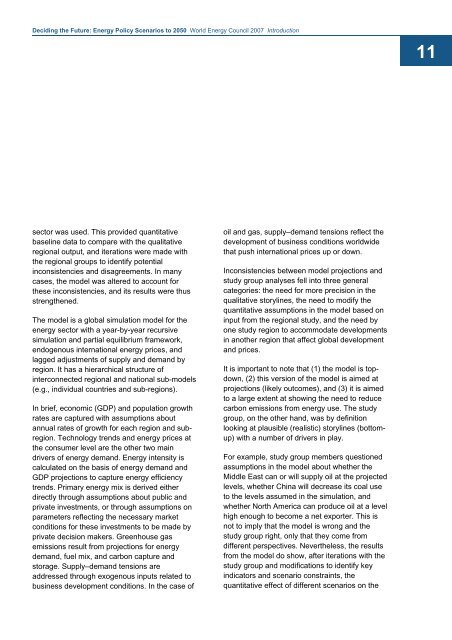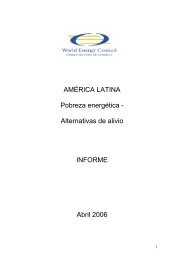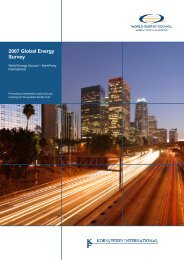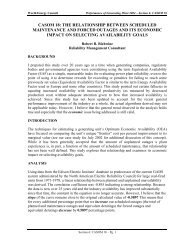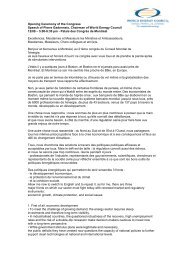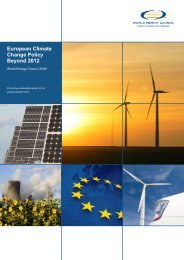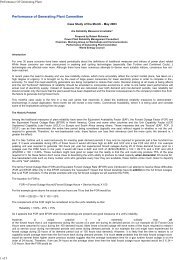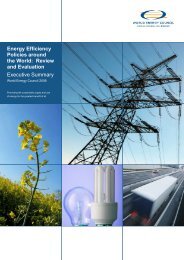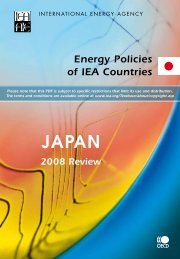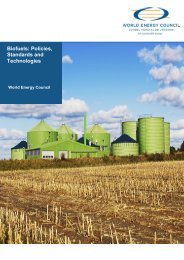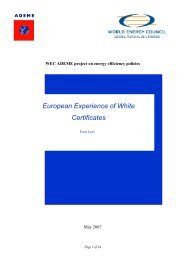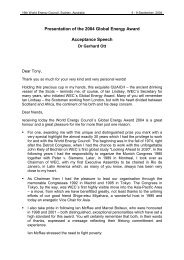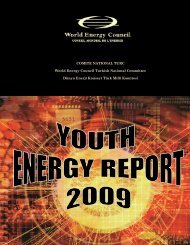Deciding the Future: Energy Policy Scenarios to 2050
Deciding the Future: Energy Policy Scenarios to 2050
Deciding the Future: Energy Policy Scenarios to 2050
You also want an ePaper? Increase the reach of your titles
YUMPU automatically turns print PDFs into web optimized ePapers that Google loves.
<strong>Deciding</strong> <strong>the</strong> <strong>Future</strong>: <strong>Energy</strong> <strong>Policy</strong> <strong>Scenarios</strong> <strong>to</strong> <strong>2050</strong> World <strong>Energy</strong> Council 2007 Introduction<br />
11<br />
sec<strong>to</strong>r was used. This provided quantitative<br />
baseline data <strong>to</strong> compare with <strong>the</strong> qualitative<br />
regional output, and iterations were made with<br />
<strong>the</strong> regional groups <strong>to</strong> identify potential<br />
inconsistencies and disagreements. In many<br />
cases, <strong>the</strong> model was altered <strong>to</strong> account for<br />
<strong>the</strong>se inconsistencies, and its results were thus<br />
streng<strong>the</strong>ned.<br />
The model is a global simulation model for <strong>the</strong><br />
energy sec<strong>to</strong>r with a year-by-year recursive<br />
simulation and partial equilibrium framework,<br />
endogenous international energy prices, and<br />
lagged adjustments of supply and demand by<br />
region. It has a hierarchical structure of<br />
interconnected regional and national sub-models<br />
(e.g., individual countries and sub-regions).<br />
In brief, economic (GDP) and population growth<br />
rates are captured with assumptions about<br />
annual rates of growth for each region and subregion.<br />
Technology trends and energy prices at<br />
<strong>the</strong> consumer level are <strong>the</strong> o<strong>the</strong>r two main<br />
drivers of energy demand. <strong>Energy</strong> intensity is<br />
calculated on <strong>the</strong> basis of energy demand and<br />
GDP projections <strong>to</strong> capture energy efficiency<br />
trends. Primary energy mix is derived ei<strong>the</strong>r<br />
directly through assumptions about public and<br />
private investments, or through assumptions on<br />
parameters reflecting <strong>the</strong> necessary market<br />
conditions for <strong>the</strong>se investments <strong>to</strong> be made by<br />
private decision makers. Greenhouse gas<br />
emissions result from projections for energy<br />
demand, fuel mix, and carbon capture and<br />
s<strong>to</strong>rage. Supply–demand tensions are<br />
addressed through exogenous inputs related <strong>to</strong><br />
business development conditions. In <strong>the</strong> case of<br />
oil and gas, supply–demand tensions reflect <strong>the</strong><br />
development of business conditions worldwide<br />
that push international prices up or down.<br />
Inconsistencies between model projections and<br />
study group analyses fell in<strong>to</strong> three general<br />
categories: <strong>the</strong> need for more precision in <strong>the</strong><br />
qualitative s<strong>to</strong>rylines, <strong>the</strong> need <strong>to</strong> modify <strong>the</strong><br />
quantitative assumptions in <strong>the</strong> model based on<br />
input from <strong>the</strong> regional study, and <strong>the</strong> need by<br />
one study region <strong>to</strong> accommodate developments<br />
in ano<strong>the</strong>r region that affect global development<br />
and prices.<br />
It is important <strong>to</strong> note that (1) <strong>the</strong> model is <strong>to</strong>pdown,<br />
(2) this version of <strong>the</strong> model is aimed at<br />
projections (likely outcomes), and (3) it is aimed<br />
<strong>to</strong> a large extent at showing <strong>the</strong> need <strong>to</strong> reduce<br />
carbon emissions from energy use. The study<br />
group, on <strong>the</strong> o<strong>the</strong>r hand, was by definition<br />
looking at plausible (realistic) s<strong>to</strong>rylines (bot<strong>to</strong>mup)<br />
with a number of drivers in play.<br />
For example, study group members questioned<br />
assumptions in <strong>the</strong> model about whe<strong>the</strong>r <strong>the</strong><br />
Middle East can or will supply oil at <strong>the</strong> projected<br />
levels, whe<strong>the</strong>r China will decrease its coal use<br />
<strong>to</strong> <strong>the</strong> levels assumed in <strong>the</strong> simulation, and<br />
whe<strong>the</strong>r North America can produce oil at a level<br />
high enough <strong>to</strong> become a net exporter. This is<br />
not <strong>to</strong> imply that <strong>the</strong> model is wrong and <strong>the</strong><br />
study group right, only that <strong>the</strong>y come from<br />
different perspectives. Never<strong>the</strong>less, <strong>the</strong> results<br />
from <strong>the</strong> model do show, after iterations with <strong>the</strong><br />
study group and modifications <strong>to</strong> identify key<br />
indica<strong>to</strong>rs and scenario constraints, <strong>the</strong><br />
quantitative effect of different scenarios on <strong>the</strong>


